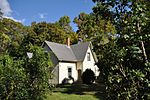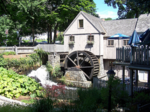Lout Pond
Plymouth County, Massachusetts geography stubsPonds of MassachusettsPonds of Plymouth, Massachusetts
Lout Pond is an 18-acre (73,000 m2) kettlehole pond in Plymouth, Massachusetts, east of Billington Sea, southeast of Morton Park, and northwest of Cooks Pond. The pond has an average depth of 19 feet (5.8 m) and a maximum depth of 36 feet (11 m). The northern and southern shores have been developed extensively. Cranberry bogs are along the western shore, and Billington Street runs along the eastern shore. Parking is available along the side of the road; however, due to the steep bank only canoes and car top boats can be launched, electric motors only. "Lout" is a name derived from the Latin lout, meaning "clay" or "mud".
Excerpt from the Wikipedia article Lout Pond (License: CC BY-SA 3.0, Authors).Lout Pond
Billington Street, Plymouth
Geographical coordinates (GPS) Address Nearby Places Show on map
Geographical coordinates (GPS)
| Latitude | Longitude |
|---|---|
| N 41.935277777778 ° | E -70.670833333333 ° |
Address
Billington Street
Billington Street
02360 Plymouth
Massachusetts, United States
Open on Google Maps



